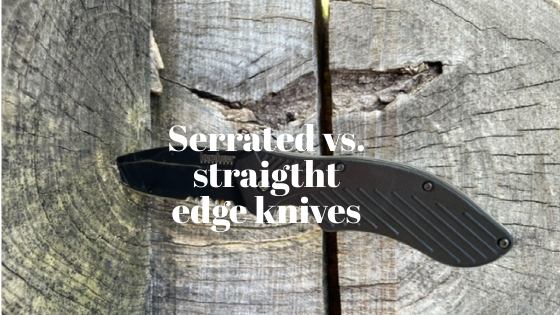Many of the knives on today’s market have serrations, some fully serrated, some partially serrated. Many knives don’t. But what is the purpose of this? And is there any real-world advantage to them? In this article, we will cover everything about serrated versus unserrated knives and which is better.
Here is the short answer:
Serrations are better for sawing through hard objects and cutting through softer objects fast. Straight edges leave cleaner cuts and are better for slicing, push cutting, shaving, and chopping. If you have to saw, go with serrations. If you have to push or slice, go with a straight edge.
Now that we have looked at the short answer, we can look closer at straight-edge knives and serrated knives to see what each edge type is good at.
Serrated knives
Serrated knives are good for things such as sawing through wood, cutting through fabrics, and cutting small ropes that can fit into the serrations. Additionally, serrations seem to stay sharp longer than plain edges.
The downside to serrations is that they do not leave clean cuts when slicing. They are better for things such as when you need to cut things fast regardless of how the cut turns out. Another downside is that serrations are hard to sharpen and take skill to perfect.
If you carry a partially serrated knife enough, you will find there are times when they help. I personally prefer a partially serrated knife as you get the benefits of serrations with the ability to make a clean cut if need be.
Here is a good serrated knife:
Spyderco Atlantic
The Atlantic is part of Spyderco’s “SALT” lineup of knives. These are knives made for salt water applications meaning they are extremely rust resistant. It has a fully serrated blade made of H-1 steel and a nearly 5-inch handle. If you want a larger serrated fixed blade that has a simple design with a unique blade, this is a knife you should look at.
Check out this knife here (link to Amazon)
Straight edges
Straight edges have the advantage of being better for chopping and push cutting. Or when you have to leave a clean line on whatever you cut such as slicing or carving.
The downside to straight edges is that they are not good for sawing. This means you cannot get the desirable, flush, edge when cutting through hard materials such as wood.
Here is a good straight-edge knife:
Case Kinzua
The Kinzua is a folding knife that has become one of my favorite carry knives of all time. It has a comfortable handle, a pocket clip with the ideal amount of grip but is also loose at the same time, and it has a 3.5-inch S35VN blade. If you want a durable and reliable carry knife, this is definitely one you should look at.
Check out this knife here (link to Amazon)
Which is better?
So which edge is better? It depends.
If you need to cut through wood and need a flush edge for whatever reason, then a serrated edge will be desirable. Or if you need to be able to cut fabric or rope or other soft materials fast, without worrying how to cut will look, then serrations will work fantastically.
If you need to be precise with your cuts or you are chopping at an object, straight edges are far better. They are far better for leaving clean lines and cuts and they will take chips and gouges when chopping rather than holes and dust like a serrated edge would. Additionally, for chopping, a straight edge with a gentle bevel (7-14 degrees) is far less likely to chip and wear the blade like serrations would.

